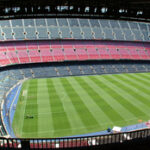The World Cup of Soccer is quickly approaching and every soccer fan on the planet is getting excited. Each time this event is held has brought dramatic games, passionate fans, and update technology. You might be wondering what technology can possibly be updated when it comes to soccer. Your first guess might be the shoes, which are somewhat updated, but that is not what I am here to showcase to all of you. Adidas’s official World Cup soccer ball, named Jabulani, is the world’s roundest ball ever created and will play a major role in every match.
Jabulani is the closest to perfection that a manufacturer has every come to creating the perfect soccer ball. Adidas first made this proclamation when they introduced the Telstar soccer ball in 1970. This ball was revolutionary because it managed to take the normal 32 panels that it takes to make a normal soccer ball and use only 12 panels. They were able to do this through thermally bonding the panels. This resulted in the elimination of inaccurate stitching and the introduction of outer panels that were 3-D like and not flat like they were in the past.
Adidas has been working hard towards achieving the same revolutionary results that they gained with the Telstar. Jabulani is this achievement as it only needed eight panels instead of the twelve panels that the company has been using. Breaking it down, this provided a nearly 70% larger striking surface for kickers because of fewer seams. A larger striking surface will result in the soccer ball moving quicker, smoother, and more accurately than before. This will result in possibly more goals being scored and soccer players during the World Cup a better soccer ball than they have ever used before.
The old soccer ball would also rotate in knuckleball like pattern. This made it extremely hard for goal keepers to properly gauge which direction the ball was going. With the smoother aerodynamics that were created with the elimination of even more panels, the Jabulani will be more stabilized. Adidas has also used what they are calling aero-grooves. These are long indentations along the panels that allow the soccer ball to turn in a more aerodynamic pattern. Goal keepers will now be able to better gauge the direction the soccer ball is going, a fair advantage seeing that soccer kickers will now be able to kick more accurately as well.
Adidas has created something truly phenomenal here. The Jabulani provides a wider kicking surface, moves more aerodynamically, built in grooves to allow kicking to be easier, and moves faster than the version that has been used for the past four decades. World Cup Soccer fans will see this ball being used in all matches and might notice the differences right away. Goals might be scored more or defended more than they have ever been before. Make sure to watch the World Cup to see this amazing ball in action before looking to own one yourself.
Sources:
Steven Mottor, My Own Review, 2010
Adidas Jabulani, www.adidas.com, 2010



